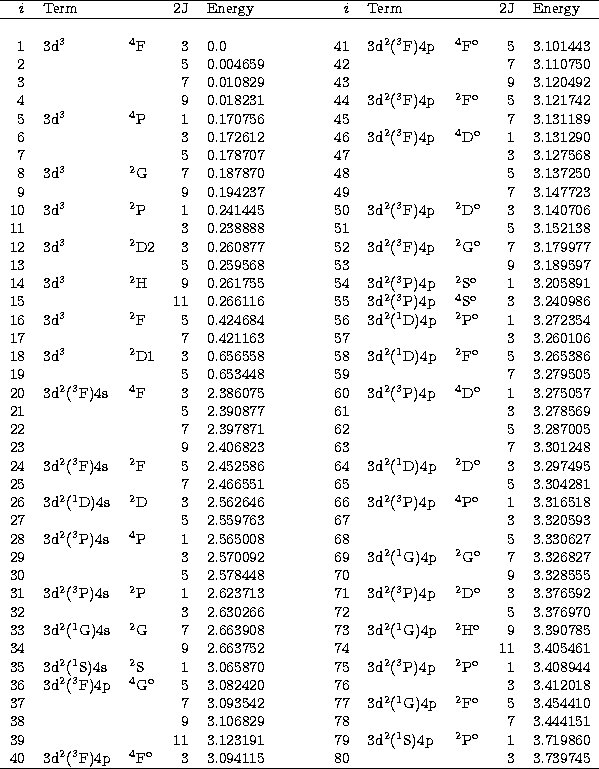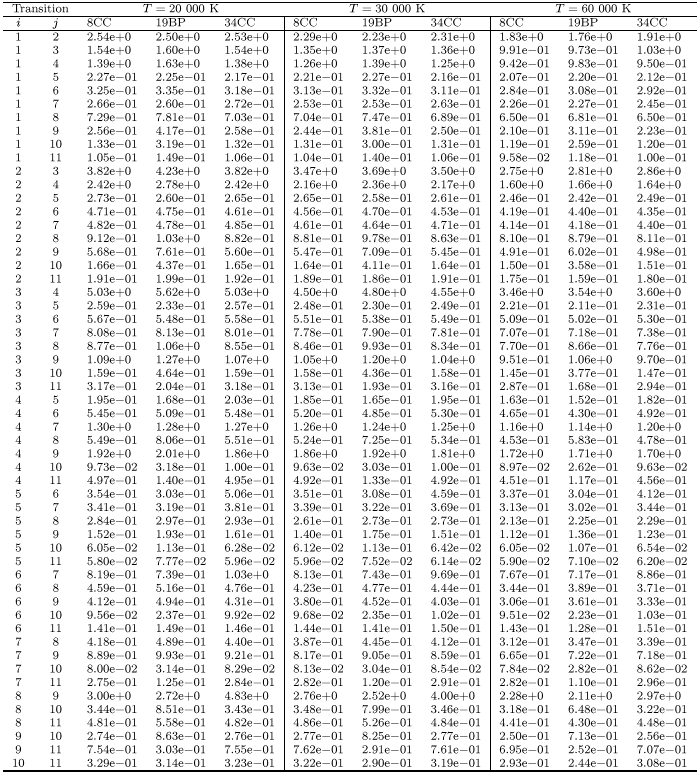The target expansions in the present work are based on
the 34-term wave function expansion for Fe VI developed by
Bautista (1996)
using the SUPERSTRUCTURE program in his non-relativistic
calculations for photoionization cross sections of Fe V.
The SUPERSTRUCTURE calculations for Fe VI were extended to include relativistic
fine structure using the Breit-Pauli Hamiltonian (Eissner et al. 1974;
Eissner 1998).
The designations for the 80 levels (34 LS terms)
dominated by the configurations
![]() ,
, ![]() and
and ![]() p
and their observed energies (Sugar & Corliss 1985),
are shown
in Table 1. These observed energies were used in the scattering Hamiltonian
diagonalization to obtain the surface amplitudes at stage STGH
(Berrington et al. 1995).
This table also provides the key to the level indices
for transitions in tabulating the Maxwellian-averaged
collision strengths.
The subset of 19-levels,
the first 8 LS terms dominated by
p
and their observed energies (Sugar & Corliss 1985),
are shown
in Table 1. These observed energies were used in the scattering Hamiltonian
diagonalization to obtain the surface amplitudes at stage STGH
(Berrington et al. 1995).
This table also provides the key to the level indices
for transitions in tabulating the Maxwellian-averaged
collision strengths.
The subset of 19-levels,
the first 8 LS terms dominated by ![]() , are used in both the intermediate
coupling BP and the non-relativistic recoupling calculations, with and
without the term coupling coefficients (TCC's)
for the purpose of comparisons (Chen & Pradhan 1998, CP).
An indication of the
accuracy of the target eigenfunctions may be obtained from
the calculated energy levels in Table 1 of CP and from the computed
length and velocity oscillator strengths for some of the dipole
fine structure transitions given in Table 2 of CP. The agreement between the
length and velocity oscillator strengths is generally about 10%, an acceptable
level of accuracy for a complex iron ion.
, are used in both the intermediate
coupling BP and the non-relativistic recoupling calculations, with and
without the term coupling coefficients (TCC's)
for the purpose of comparisons (Chen & Pradhan 1998, CP).
An indication of the
accuracy of the target eigenfunctions may be obtained from
the calculated energy levels in Table 1 of CP and from the computed
length and velocity oscillator strengths for some of the dipole
fine structure transitions given in Table 2 of CP. The agreement between the
length and velocity oscillator strengths is generally about 10%, an acceptable
level of accuracy for a complex iron ion.
 |
The collision calculations in the present work, as in the earlier works in Papers III, VI, XVIII and XXVII of the IP, entail the calculation of the reactance matrix (the K-matrix) which yields the collision strengths. In the NR algebraic recoupling approach, the K-matrices are obtained as usual by the different stages of the R-matrix package (Berrington et al. 1995) in LS coupling. The K-matrices are subsequently transformed from LS coupling to pair coupling (Saraph 1972, 1978), using the STGFJ code (Luo & Pradhan 1990; Zhang & Pradhan 1995a) which is an extension of the NR LS coupling asymptotic region code, STGF (Hummer et al. 1993). The collision strengths were calculated for a large number of electron energies ranging from 0 to 10 Rydbergs by 34CC. This energy range was carefully chosen in order to obtain detailed structures of collision strengths in the region where they are dominated by resonances, as well as in an extended region where resonances are not important or have not been included but which are necessary to obtain accurate Maxwellian-averaged rate coefficients for the electron temperature range of interest. As the electron Maxwellian at a given temperature is weighted towards lower energies, it is desirable and usually necessary to use a fine mesh of energies in the near-threshold region. The mesh is coarser at higher energies not only because it is weighted less in rate coefficients, but also because the calculations are more CPU time consuming as more target thresholds are accessible resulting in a higher number of open channels than at low energies.
In order to delineate the extensive near-threshold resonance structures,
an effective quantum
number ![]() -mesh was used to obtain the collision strengths at 8913
energy points in the range E = 0 - 0.25 Rydbergs. On this so called
"quantum defect'' mesh,
100 points (
-mesh was used to obtain the collision strengths at 8913
energy points in the range E = 0 - 0.25 Rydbergs. On this so called
"quantum defect'' mesh,
100 points (![]() ) are obtained in each interval (
) are obtained in each interval (![]() ,
, ![]() .The
.The ![]() -mesh ensures equal sampling of resonances in each successive interval,
-mesh ensures equal sampling of resonances in each successive interval,
![]() ,
, ![]() where
where ![]() ;
; ![]() is the energy of the
particular
target threshold to which the resonance series converges. In the energy
region E = 0.25 - 10 Rydbergs, a constant energy mesh was used. A practical
reason for terminating the
is the energy of the
particular
target threshold to which the resonance series converges. In the energy
region E = 0.25 - 10 Rydbergs, a constant energy mesh was used. A practical
reason for terminating the ![]() -mesh at 0.25 Rydberg is that it would
take considerably more computing time and memory resources, owing to a
large number of additional open channels at higher energies.
The calculations
are therefore optimised so as to obtain extensive delineation of resonances for
the collision strengths for forbidden transitions in the low energy region
that contributes predominantly to the Maxwellian rate coefficient.
For the optically allowed transitions, the dominant contribution may arise
from higher partial waves and higher energy regions since
-mesh at 0.25 Rydberg is that it would
take considerably more computing time and memory resources, owing to a
large number of additional open channels at higher energies.
The calculations
are therefore optimised so as to obtain extensive delineation of resonances for
the collision strengths for forbidden transitions in the low energy region
that contributes predominantly to the Maxwellian rate coefficient.
For the optically allowed transitions, the dominant contribution may arise
from higher partial waves and higher energy regions since ![]() ) where resonances are relatively less important.
) where resonances are relatively less important.
It is convenient to divide the overall calculation into groups of total (e + ion)
symmetries ![]() according to their multiplicity, i.e. (2S+1) = 1,3, and
5 (L and
S are the
corresponding total orbital and spin angular momenta).
Following algebraic calculations at the
R-matrix STG2 stage in LS coupling, the
according to their multiplicity, i.e. (2S+1) = 1,3, and
5 (L and
S are the
corresponding total orbital and spin angular momenta).
Following algebraic calculations at the
R-matrix STG2 stage in LS coupling, the ![]() symmetries are then recoupled in
the program RECUPD to obtain total
symmetries are then recoupled in
the program RECUPD to obtain total ![]() (where J=L+S).
At low impact electron energies, especially for forbidden
transitions between the low-lying levels in Fe VI, contributions
to the collision strengths from total symmetries
(where J=L+S).
At low impact electron energies, especially for forbidden
transitions between the low-lying levels in Fe VI, contributions
to the collision strengths from total symmetries ![]() with small J are
dominant and those from large J are negligible.
We calculated partial wave contributions from total angular
momenta of the (e + ion) system with J = 0 - 15.
The corresponding
SL's (for both even and odd parities) included are
with small J are
dominant and those from large J are negligible.
We calculated partial wave contributions from total angular
momenta of the (e + ion) system with J = 0 - 15.
The corresponding
SL's (for both even and odd parities) included are
![]()
![]()
![]()
The sum over the symmetries included should be sufficient
to ensure convergence of the total collision strengths for most of the
non-dipole transitions.
As in several earlier calculations (e.g. for Fe IV,
Zhang & Pradhan 1995a), Coulomb-Bethe (CBe) approximation
was employed to account for the large ![]() contributions to supplement the collision strengths for optically allowed
transitions in the energy range 0-10 Rydbergs. As the ion abundance peak of
Fe VI in stellar sources is at the temperature 200 000 K
(Arnaud & Rothenflug 1985), the collision strengths were calculated for energy
range 10-100 Rydbergs or so for optically allowed transitions by
CBe approach and for forbidden transitions by linking a tail with
contributions to supplement the collision strengths for optically allowed
transitions in the energy range 0-10 Rydbergs. As the ion abundance peak of
Fe VI in stellar sources is at the temperature 200 000 K
(Arnaud & Rothenflug 1985), the collision strengths were calculated for energy
range 10-100 Rydbergs or so for optically allowed transitions by
CBe approach and for forbidden transitions by linking a tail with
![]() decrease in collision strengths.
The electric dipole
fine structure oscillator strengths required for CBe top-up were
obtained from the BP SUPERSTRUCTURE calculations (as given in Table 2
of CP for selected transitions).
decrease in collision strengths.
The electric dipole
fine structure oscillator strengths required for CBe top-up were
obtained from the BP SUPERSTRUCTURE calculations (as given in Table 2
of CP for selected transitions).
 |
At the STG2 stage of the R-matrix calculations, it is required to
specify the (N+1)-electron configurations that constitute the bound
channel terms ![]() 's in the wave function expansion. However, the
computer time and memory of the calculation are dependent on the number
of such configurations included. A judicious choice needs to
be made depending on whether any given particular configuration is
important in the calculations or not. Therefore, in addition to those
configurations required by the orthogonality condition between the
continuum orbitals and the bound target orbitals, a number of complete
trial calculations were carried out to select the full set of bound
channel configurations employed in the present calculations.
Especially, those configurations with open 3p subshell (
's in the wave function expansion. However, the
computer time and memory of the calculation are dependent on the number
of such configurations included. A judicious choice needs to
be made depending on whether any given particular configuration is
important in the calculations or not. Therefore, in addition to those
configurations required by the orthogonality condition between the
continuum orbitals and the bound target orbitals, a number of complete
trial calculations were carried out to select the full set of bound
channel configurations employed in the present calculations.
Especially, those configurations with open 3p subshell (![]() or
or
![]() ) have noticeably influence on the results (the
very broad near-threshold resonance features). Table 3
of CP lists these configurations according to even and odd parity.
The earlier CP paper also gives a discussion of the bound channel
configurations and associated resonance structures.
) have noticeably influence on the results (the
very broad near-threshold resonance features). Table 3
of CP lists these configurations according to even and odd parity.
The earlier CP paper also gives a discussion of the bound channel
configurations and associated resonance structures.
 |
Copyright The European Southern Observatory (ESO)